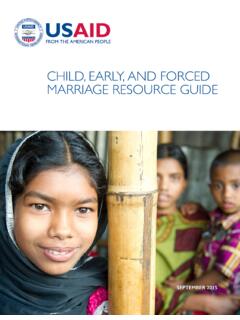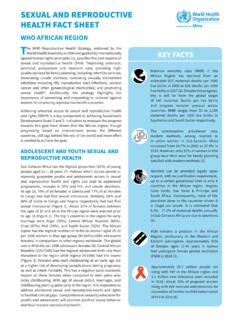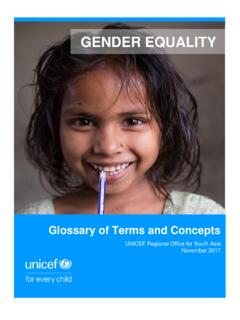Transcription of Provision of accommodation for 16 and 17 year olds who …
1 1 Prevention of homelessness and Provision of accommodation for 16 and 17 year old young people who may be homeless and/or require accommodation Guidance to children s services authorities and local housing authorities about their duties under Part 3 of the Children Act 1989 and Part 7 of the Housing Act 1996 to secure or provide accommodation for homeless 16 and 17 year old young people. 2 Crown copyright, 2018 Copyright in the typographical arrangement rests with the Crown. You may re-use this information (not including logos) free of charge in any format or medium, under the terms of the Open Government Licence. To view this licence visit This document/publication is also available on our website at If you have any enquiries regarding this document/publication, complete the form at or write to us at: Ministry of Housing, Communities and Local Government Fry Building 2 Marsham Street London SW1P 4DF Telephone: 030 3444 0000 Department for Education Sanctuary Buildings Great Smith Street London SW1P 3BT Telephone: 0207 340 7000 For all our latest news and updates follow us on Twitter: April 2018 ISBN: 978-1-4098-5242-1 3 Contents Contents 3 Definitions 5 Chapter 1: Introduction 6 Chapter 2.
2 Supporting families to stay together 8 Young people living with their families 8 16 and 17 year olds who may require accommodation with children and/or partners 8 Chapter 3: Children s services duties towards 16 and 17 year olds who seek help because of homelessness, or being threatened with homelessness 10 Duties owed to young people who may require accommodation 10 Undertaking Assessments 13 Timescales 15 Young person s wishes and feelings 16 16 and 17 year olds from one local authority area who seek assistance from children s services in another local authority area 19 Young People in Custody 19 Provision of accommodation under section 17 of the 1989 Act 20 The duty to refer to housing services 21 Chapter 4: Duties placed on housing services when 16 and 17 year olds seek help because of homelessness or being threatened with homelessness 23 Initial Assessment 23 Priority need 23 4 Ending the prevention and relief duties 26 Where section 20 and Part 7 duties are not owed 29 Young people from one district who seek assistance from housing services in another district 29 Chapter 5: The Provision of suitable accommodation for 16 and 17 year olds.
3 31 Placements by children s services 31 Placements by housing services 32 Considerations for both children s and housing services 32 Chapter 6: Joint working to prevent and resolve homelessness among 16 and 17 year olds 34 Provision of general advice and information 34 Operational joint working - joint protocols 35 Operational joint working integrated youth homelessness services 37 Strategic joint working 38 Annex: Factors to be considered by children s services when assessing 16-17 year olds who may be children in need 39 5 Definitions For the purposes of this guidance: a. Homeless in relation to housing services refers to section 175 of the Housing Act 1996. b. Requiring accommodation in relation to children s services refers to section 20 of the Children Act 1989.
4 C. Main accommodation duty refers to section 193 of the Housing Act 1996. d. Threatened with homelessness means likely to become homeless within 56 days. e. Young people refers to 16 and 17 year olds, including those who are pregnant or have children of their own. f. Housing services means local housing authority. g. Children s services means Local Authority Children s Social Care. h. The 1989 Act refers to the Children Act 1989. i. The 1996 Act refers to the Housing Act 1996. j. An Eligible Child is a child who is aged 16-17 and who has been looked after by a local authority for at least 13 weeks since they were 14, and who continues to be looked after. k. A Relevant Child is a child aged 16-17 who is no longer looked after by a local authority, but who was before they ceased to be looked after an eligible child [looked after for at least 13 weeks after the age of 14 and has been looked after for some time while they were aged 16/17].
5 L. A Qualifying Child is a child aged 16+ who has been looked after for a period of time amounting to less than 13 weeks since their 14th birthday, and was looked after on or after their 16th birthday. 6 Chapter 1: Introduction This joint guidance was first published in April 2010 following a number of judgements handed down by the House of Lords in cases concerning the interrelationship between the duty under section 20 of the Children Act 1989 ( the 1989 Act ) and duties under Part 7 of the Housing Act 1996 ( the 1996 Act ) where young people aged 16 or 17 require accommodation . The guidance has been amended to reflect new duties introduced through the Homelessness Reduction Act 2017 ( the 2017 Act ), and to incorporate other relevant updates.
6 Case law has clarified the relationship between the duty under section 20 of the Children Act 1989 ( the 1989 Act ) and duties under Part 7 of the Housing Act 1996 ( the 1996 Act ) in the case of 16 or 17 year olds who require accommodation . The House of Lords case R (G) v Southwark [2009] UKHL 26 held that, where a 16 or 17 year old is owed duties under section 20 of the 1989 Act, this takes precedence over the duties in the 1996 Act in providing for children in need who require accommodation . Where the specific duty is owed under section 20 of the 1989 Act, a 16 or 17 year old should be accommodated under that Provision rather than looking to the general duty owed to children in need and their families under section 17 of the 1989 Act. Whilst the section 20 Children Act 1989 duty takes precedence, housing services also have duties towards young people who are homeless or threatened with homelessness.
7 Duties owed by each service will depend on a range of factors, including which service they initially seek help from; the outcomes of any assessments and enquiries; and the wishes and feelings of the young person and their family. It is therefore essential that children s services and housing services work together to plan and provide services that are centred on young people and their families, and prevent young people from being passed back and forth between services. For more information on joint working between children s services and housing services see chapter 6. 16 and 17 year olds who are homeless or threatened with homelessness are likely to be vulnerable and will often be at risk of harm in the absence of intervention. Safeguarding and promoting their welfare should be central to service Provision .
8 If there is any concern that a child may be suffering, or likely to suffer, significant harm then local safeguarding procedures must be followed. The statutory guidance 'Working together to Safeguard Children sets out what is expected of organisations to safeguard and promote the welfare of children. This guidance does not address the wider responsibilities of local authority children s services and their partners to identify and support families where children and young 7 people may be at risk of negative outcomes, including homelessness in the future, by delivering integrated and targeted services in their area. This guidance is solely concerned with the functions of children s services and housing services when young people seek help from, or are referred to, local authorities because of homelessness or being threatened with homelessness.
9 This guidance is issued jointly by the Secretary of State for Education and the Secretary of State for Housing, Communities and Local Government under section 7 of the Local Authority Social Services 1970 and section 182 of the Housing Act 1996. Section 7 of the 1970 Act requires local authorities, in exercising their social services functions, to act under the general guidance of the Secretary of State; unless there are exceptional reasons in individual cases authorities are expected to comply with this guidance. Section 182 of the 1996 Act requires housing authorities and social services authorities, in the exercise of their functions relating to homelessness and the prevention of homelessness, to have regard to such guidance as may from time to time be given by the Secretary of State.
10 8 Chapter 2: Supporting families to stay together Young people living with their families The Secretary of State for Housing, Communities and Local Government and the Secretary of State for Education consider that, generally, it will be in the best interests of most young people to live in the family home, or, where this is not safe or appropriate, with responsible adults in their wider family and friends network. When a 16 or 17 year old is seeking support because they are homeless or threatened with homelessness, housing services and children s services responses should explicitly recognise this and work pro-actively with young people and their families to identify and resolve the issues which have led to the homelessness crisis. This could involve family support such as family mediation or family group conferences.













